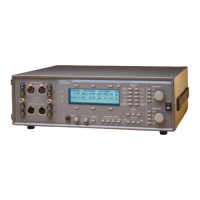the ATS-1 Dual Domain should have XLR connectors on one end for
connection to the test instrument. The other end of the cables must
have a connector appropriate for the device under test. Adapters may
be used to adapt a standard cable to the device or test instrument.
If the device under test uses balanced XLR connectors, the
connections can be made directly with XLR cables.
When cables or adapters for unbalanced connectors are used, pin 2 of
the XLR connector should connect to the signal conductor and pin 3
of the XLR connector should connect to the ground. Also be sure to
select an unbalanced generator configuration (see page 3-42).
The ATS-1 Dual Domain’s Generator Outputs should be connected to
the analog inputs of the device under test. The Analyzer Inputs should
be connected to the analog outputs of the device under test.
For single channel devices, use only the Channel A analog input and
output connectors. For stereo (or 2-channel) devices, Channel A is
usually used for the Left channel and Channel B for the Right
channel.
To simplify connection, analog test cables are often marked with the
following color code:
.
Left in: Blue (sometimes black is used instead)
.
Left out: Yellow
.
Right in: Red
.
Right out: Green
When you connect your device under test, it is a good idea to select
the proper input and output impedances and the
balanced/unbalanced configuration for the generator. The input
impedances are controlled by the Main Panel in Level mode. Follow
these steps to get there:
The lower center soft key controls the termination of the channel A
input. The lower right soft key controls the termination of the channel
B input. Each input can be selected as ‘HiZ’ or ‘LoZ’. The HiZ
selection provides input terminations near 100 kΩ. The LoZ selection
provides input terminations of 600 Ω.
3 Operation
External Connections Operational Overview
3-42 ATS-1 Dual Domain User's Manual

